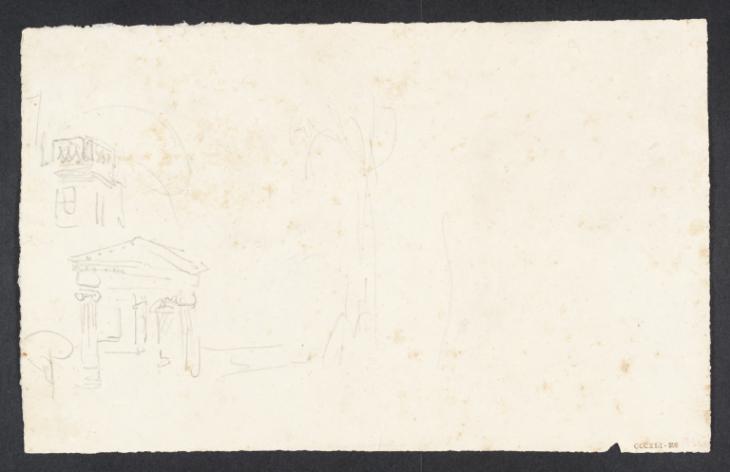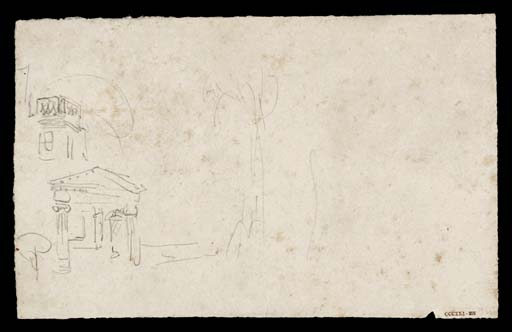Joseph Mallord William Turner The Summer-house in the Garden at 'The Limes', Mortlake ?1826
Image 1 of 2
Joseph Mallord William Turner,
The Summer-house in the Garden at 'The Limes', Mortlake
?1826
Joseph Mallord William Turner 1775–1851
The Summer-house in the Garden at ‘The Limes’, Mortlake ?1826
D34018
Turner Bequest CCCXLI 299
Turner Bequest CCCXLI 299
Pencil on white wove paper, 144 x 229 mm
Watermark ‘1826’
Inscribed in ?red ink ‘299’ bottom right (now faint)
Stamped in black ‘CCCXLI – 299’ bottom right
Watermark ‘1826’
Inscribed in ?red ink ‘299’ bottom right (now faint)
Stamped in black ‘CCCXLI – 299’ bottom right
Accepted by the nation as part of the Turner Bequest 1856
References
1909
A.J. Finberg, A Complete Inventory of the Drawings of the Turner Bequest, London 1909, vol.II, p.1081, CCCXLI 299, as ‘Building, with classical porch and trees’. c.1830–41.
This sketch relates to Turner’s oil painting Mortlake Terrace, the Seat of William Moffatt, Esq. Summer’s Evening, shown at the Royal Academy in 1827 (National Gallery of Art, Washington, DC).1 As noted in the Introduction to the present subsection, this is one of four drawings which are supplementary or complementary to the studies in the Mortlake and Pulborough sketchbook (Tate; Turner Bequest CCXIII), probably in use at Mortlake in 1825.
The direct source for Summer’s Evening is a double-page Mortlake and Pulborough sketch (Tate D18733–D18734; Turner Bequest CCXIII 15a–16). The present sketch focuses on the small but elaborate Ionic summer-house in the garden of ‘The Limes’, with the trees immediately beside it summarily indicated. The detail above of the corner of a building topped by a balustrade does not represent the riverside porch of the main house, nor apparently any other aspect of the building as recorded by Turner or as it exists today, and may have been an incidental detail of an adjacent property beyond the garden. There is a careful, annotated detail of the summer-house in the Mortlake and Pulborough book (Tate D18728; Turner Bequest CCXIII 13). See also Tate D25516 and D25517 (Turner Bequest CCLXIII a 1, 2).
The present sheet became separated at some stage from the three similar studies identified by Finberg2 catalogued in the present subsection, and misleadingly came to rest among a large number of Continental pencil studies on grey paper.3 As noted in the Introduction, the ‘1826’ watermark here suggests that all four were made on the same occasion in that year.
Technical notes:
In common with the other three separate Mortlake studies (Tate D25516–D25518; Turner Bequest CCLXIII a 1, 2, 3) the paper appears off-white, presumably through age, with brown mottling. The darkening and staining is not as pronounced as in the three other cases, suggesting that the present sheet was kept in slightly different conditions when it became separated from the rest.
The edges are all slightly irregular. There is a shallow diagonal crease at the top left, matching those at the top right of D25516 and D125518, which may also relate in some way to the loss of about the same size at the top left of D25517, suggesting that the four sheets were at least initially kept together. There is a more prominent double fold at a similar angle with an associated slight nick to the lower edge at the bottom right.
Verso:
Blank; inscribed in pencil ‘[?241 | O]’ top left, upside down, and ‘299’ bottom right
Matthew Imms
December 2014
How to cite
Matthew Imms, ‘The Summer-house in the Garden at ‘The Limes’, Mortlake ?1826 by Joseph Mallord William Turner’, catalogue entry, December 2014, in David Blayney Brown (ed.), J.M.W. Turner: Sketchbooks, Drawings and Watercolours, Tate Research Publication, April 2015, https://www


